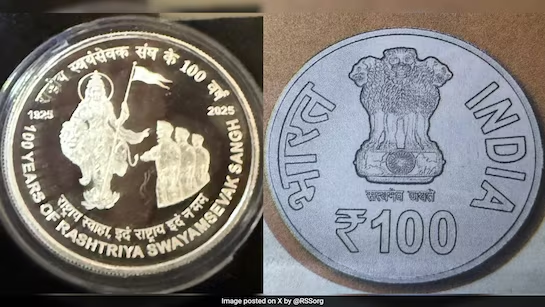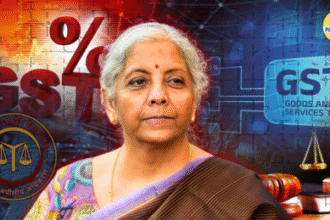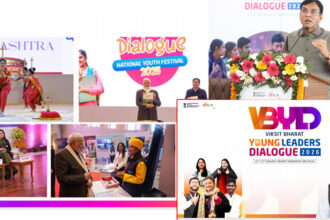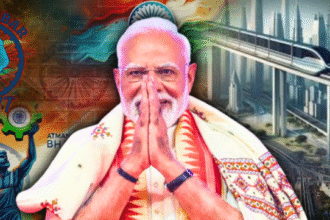On October 1, Prime Minister Narendra Modi released a ₹100 commemorative coin and a postal stamp to mark the centenary of the Rashtriya Swayamsevak Sangh (RSS). Beyond the metal and paper, this move has ignited a fierce political and ideological debate, revealing once again how India’s past remains a contested battlefield for its present and future.
The commemorative coin, the first to depict Bharat Mata on Indian currency, features RSS swayamsevaks bowing before her in their traditional uniform, along with the Sangh’s guiding motto: “Rashtray Swaha, Idam Rashtraya, Idam Na Mama” (everything for the nation, nothing for the self). The postal stamp released alongside portrays RSS volunteers in the 1963 Republic Day Parade, a moment that linked the Sangh to national service during the aftermath of the India–China war.
For an organisation vilified, misrepresented, and systematically excluded from the “official” story of India for decades, this moment carried the weight of vindication. The RSS, founded in 1925 by Dr. Keshav Baliram Hedgewar in Nagpur, has completed a century of service, discipline, and cultural awakening — often without recognition, often under hostility, yet with an unbroken commitment to “Nation First.”
A coin that speaks more than words
The ₹100 coin bears an image of Bharat Mata, flanked by swayamsevaks bowing in reverence, and the motto: “Rashtray Swaha, Idam Rashtraya, Idam Na Mama” — everything dedicated to the nation, nothing claimed for the self.
It is not just artistry; it is philosophy struck in metal. A reminder that service to Bharat transcends individual ambition, ideology, or dynasty.
The postal stamp showing RSS participation in the 1963 Republic Day Parade further anchors the Sangh’s role in moments of national crisis. At a time when India reeled from the 1962 humiliation by China, swayamsevaks stood shoulder to shoulder in discipline and service.
PM Modi’s tribute: A century of silent service
PM Modi, himself a pracharak of the Sangh, spoke of the RSS as an organisation that never carried bitterness despite relentless vilification. “The Sangh fought British atrocities, sheltered freedom fighters, and its leaders endured jail during the independence movement,” he said.
Unlike political parties that sought power, RSS devoted itself to moulding character, building a nation from the grassroots up. Schools, shakhas, social service networks, relief work during disasters, and campaigns for self-reliance — these rarely made headlines, but they built the foundations of civilizational strength.
Opposition outrage: Noise without memory
Predictably, the Congress and Left erupted in anger.
- The Congress dredged up Patel’s 1948 letters, ignoring the fact that Patel himself banned and unbanned the RSS within a year, recognising its utility to the nation. If Patel truly believed the Sangh was an enemy of India, why restore it? The Congress conveniently forgets this.
- The CPI(M) called Bharat Mata “sectarian,” exposing its ideological disconnect with India’s civilisational soul. An image millions revere as national motherhood is dismissed as “Hindutva propaganda” by those who once excused Maoist terror and even questioned India’s stand in the 1962 war.
Irony has never been kind to the Opposition. Congress, which filled stamps, coins, airports, and welfare schemes with Nehru–Gandhi portraits, suddenly finds “misuse of state machinery” when RSS receives recognition. Their selective outrage only underlines their fear: the monopoly over India’s national narrative is slipping away.
History vs Memory: The real contrast
For decades, “history” as written by Congress-influenced academicians cast RSS into the margins — painted as communal, reactionary, or irrelevant.
But memory among millions told a different story: of swayamsevaks serving during Partition relief, rebuilding villages after floods, working in tribal belts, and inspiring institutions like the Vanvasi Kalyan Ashram or Vidya Bharati schools.
Now, history and memory are colliding. The coin is not just currency; it is recognition that the Indian state no longer disowns one of its most enduring nationalist movements.
The electoral undercurrent: Symbolism as strategy
Make no mistake — symbolism matters in politics. With the RSS turning 100, PM Modi has ensured that the Sangh’s contribution is etched not just in the memories of swayamsevaks but in the very fabric of the Republic.
At a time when Congress clings to Patel’s letters to attack the RSS, PM Modi reclaims Patel’s spirit — unity, discipline, and nation-first — as qualities the RSS embodies. For the BJP base, this coin is more than metal; it is validation. For the broader electorate, the depiction of Bharat Mata on currency is a statement: this government anchors itself in Indian civilizational pride, not imported ideologies.
Opposition parties risk alienating voters by sneering at Bharat Mata. To millions, she is not sectarian — she is the very embodiment of India. By dismissing her, Congress and the Left appear to dismiss India itself.
A century of RSS, A future for Bharat
The release of the coin is not just a tribute to the past; it is also a celebration of the present. It is a declaration about the future: that India’s nationhood cannot be defined by dynastic politics or narrow ideological lenses, but by civilisational confidence.
RSS at 100 is no longer a movement to be ignored. It is woven into the state’s symbols, into the political mainstream, and into the daily life of the nation. From vilification to vindication — this journey itself mirrors India’s struggle to reclaim its narrative.
In the end, what the Opposition calls “sectarian” is, for millions, the truest image of Bharat. And as Bharat Mata now shines on Indian currency, the question remains: was it ever sectarian, or was it simply inevitable?






